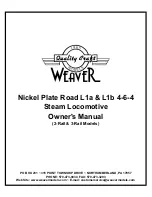
Aircraft Technical Manual
Jabiru Aircraft
Pty Ltd
J120, J160, J170, J200/J400, J230/J430, J250/J450 Variants
This document is controlled while it remains on the Jabiru server. Once this no longer applies the document becomes uncontrolled.
ISSUE
1
2
3
4
5
Dated: 29th October 2014
Issued By: AS
Page: 211 of 298
If necessary, remove exhaust manifolds from engine. Note that loosening the screws holding the
extractors to the cylinder heads will often assist in removing muffler.
7.10.3 Exhaust Inspection
Required Tools:
Tools as required by Section 7.1
Spanners / Socket Wrench
Rubber expansion plugs
Manometer or gauge
Large container with water (to submerge parts)
Parts and Material:
Replacement exhaust parts (if required)
Type of Maintenance:
Heavy Maintenance
Level of Certification:
L2 or LAME (A&P or LSA Repairman / Maintenance)
Return to Service:
L2 or LAME (A&P or LSA Repairman / Maintenance)
As all exhaust systems are subject to burning, cracking and general deterioration from alternate
thermal stress and vibration, inspection is very important and should be carried out every 100
hours of operation.
In addition, an inspection of the exhaust system must be undertaken anytime exhaust fumes are
noticed in the cabin.
1.
Remove engine cowlings (see Section 7.1).
2.
Inspect complete system, starting at the connection to the head; securing bolts and moving
outwards. Especially check areas adjacent to welds. Look for exhaust gas deposits in
surrounding areas, indicating that exhaust gas is escaping through a hole or crack.
For a more thorough inspection, the following procedure is recommended.
1.
Remove manifolds and/or muffler.
2.
Use rubber expansion plugs to seal openings.
3.
Using a manometer or gauge, apply approximately 1-1/2 psi (3 inches of mercury) air pressure
while the manifold and/or muffler are submerged in water. All leaks will appear as bubbles and
can be readily detected.
4.
It is recommended that any exhaust system component found to be defective is replaced with a
new part before the next flight.
7.10.4 Exhaust Installation
Required Tools:
Spanners / Socket Wrench
Screwdrivers
Parts and Material:
N/A
Type of Maintenance:
Heavy Maintenance
Level of Certification:
L2 or LAME (A&P or LSA Repairman / Maintenance)
Return to Service:
L2 or LAME (A&P or LSA Repairman / Maintenance)
For installation reverse the removal procedure given above.
If the exhaust manifolds / extractors have been loosened or removed, then during installation
care must be taken to position the muffler correctly. Carry out a test fit of the muffler to the
system, then stand back and check that it is positioned at the engine centreline and is true and
straight. If necessary adjust the manifold or extractors. Before final fit ensure that extractors /
manifolds are aligned well with the exhaust ports. Poor alignment will result in exhaust port
damage (particularly for 2-bolt flanges). Tighten all extractor screws & assemble.
















































